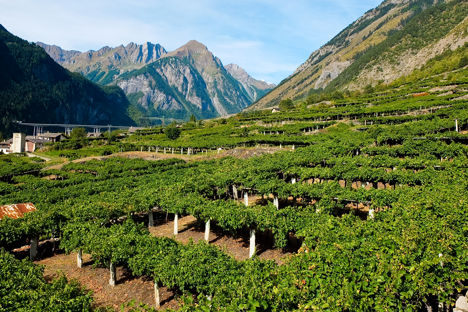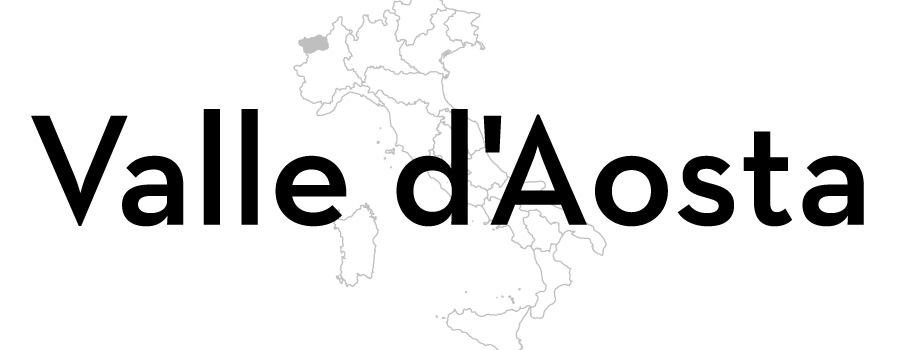
The wines of Valle d'Aosta
Marco Rossi turns his attention to Valle d'Aosta, a small region in the north of the country.
View more from this series:
Italian wineValle d'Aosta (Aosta Valley)is the smallest wine producing territory in all of Italy and, as a northern alpine region, there is a strong French influence in everything from the culture to the language.
In terms of wine, Valle d'Aosta is a standalone region which at one point had so many grape varieties growing you could write a book about it. With winemaking roots that stretch back to before Roman times, it has an incredibly rich history. Unfortunately, phylloxera (an aphid-like pest) killed most of the vines on local farms in the 1860s, wiping out the majority of the region’s wine heritage.
However, the wines produced today are still elegant mountain wines, perfectly reflecting the beauty of the stunning landscapes and colors of the valley. The mineral taste conquers your palate with every sip and international varieties have slowly filled the gap created by phylloxera, but the wines to look out for are made from unique grapes such as Fumin, Priè Rouge, Priè Blanc and many others.
It might be the smallest wine-producing territory in Italy, but Valle d’Aosta has remained an important region. The local government managed to create a single DOC in 1985 which managed to bring the entire winemaking scene’s quality, standards and communication up to scratch. Today, the region’s seven sub-areas perfectly express the different terroirs of this unique land.
DOCs
This DOC covers the entire region and is quite wide considering the regional dimensions and limited wine production. It embraces the left and right bank of the Dorea Baltea River, an area that is slightly easier to cultivate, with a softer climate than the surrounding mountain areas.
Visual: ruby red with garnet shades when older
Bouquet: hints of blackberries and blueberries, a slight clove aroma and green pepper with a nice minerality
Taste: balanced, full-bodied and quite persistent with a strong mineral flavour
Pairing: soups, Toma and Fontina cheese, fondue and game
Must try:
Traditional: Syrah Valle d'Aosta Coteau Latour Les Cretes
New Wave: Valle d'Aosta Pinot Gris Lo Triolet
This is one of the highest wine producing areas in Europe, taking place at an altitude of 900–1200 metres above sea level. The name comes from the two main hamlets embraced by the DOC, and the vines of this area are piè-franco (non-grafted) as phylloxera was unable to live so high up. Native varieties like Priè Rouge and Priè Blanc are at their best here.
Visual: pale yellow with golden shades
Bouquet: aromatic herbs and hawthorn, hints of white fruits like Williams pear and a spicy aroma of white pepper
Taste: high acidity and intense minerality
Pairing: fish and white meat, fresh cheese
Must try:
Traditional: Blanc de Morgex et de La Salle Nathan Ermes Pavese
New Wave: Blanc de Morgex et de La Salle Vevey Albert
This is the largest DOC in Valle d'Aosta. Wines from Torrette were quite famous at the beginning of last century, combining local grapes such as Fumin Vine de Nus with French ones such as Gamay and Pinot Noir. If you find the word superieur on the label it is not referring to a higher alcohol content (as usually it does in Italy) but highlights a wine as coming from the highest mountains and sunniest vineyards.
Visual: ruby red with violet shades
Bouquet: intense aroma of red and black berries and cherry jam with a slight spiciness
Taste: round and full, with nice acidity and good tannins
Pairing: beef, veal and cheese
Must try:
Traditional: Torrette Superieue Elevè en Fut de Chene Maison Anselmet
New Wave: Torrette Superieur Valle d'Aosta DOC Ottin
Named after the main hamlet of the area Chambave with only 1,000 inhabitants, this wine’s main grape is Moscato Bianco (Muscat) resulting in an aromatic but very elegant finish. The flétri (withered) version of this DOC wine is the most precious, made from the the best white Muscat grapes that are kept and dried in special ventilated rooms protected from the sun. It is produced only when the precious grapes lose most of their moisture, amplifying their sweet and aromatic richness. Muscat Flétri has an intense aroma with hints of honey and jam, which is suitable for many occasions at the end of a meal. It pairs very well with sweet pastries.
Visual: straw yellow, pale green hues, crystal clear
Bouquet: refined, aromatic, floral and fruity. Scents of apricot, sage, thyme and peach
Taste: consistent, dry, softly alcoholic and lively.
Pairing: shellfish and medium-aged cheeses
Must try:
Traditional: Valle d'Aosta Chambave La Crotta di Vegneron
New Wave: Valle d'Aosta Chambave Muscat La Vrille
Winemaking in Donnas has ancient traditions, even though it has always been tough to cultivate the vines against the mountain using stone walls. The vineyards are characterized by their small size and fragmented structure. In winter, while the wine matures, the farmers build and repair the traditional pergola trellises. The harvest begins in September with the Pinot Grigio, continues at the beginning of October with the famous Vien de Nus, in the second half of October with Nebbiolo-Picotendro and ends in mid-November with the late harvest of the Nebbiolo used for Vieilles Vignes wines.
Visual: ruby red with garnet shades
Bouquet: elegant, red and black berries, quite spicy
Taste: dry, balanced, good tannins and slightly bitter
Pairing: red meat, game and seasoned cheeses
Must try:
Traditional: Valle d'Aosta Napoleon Caves Coperatives de Donnas
New Wave: Riserva Pantheon Cru Piantin Picotendro az Vitivinicola Selve
Enfer is obtained by using at least eighty-five percent Petit Rouge grapes in addition to Vien de Nus, Neyret, Dolcetto, Pinot Noir and Gamay. Its production area coincides with the area of Arvier and the vineyards from which it originates are cultivated in a natural amphitheater characterized by strong sunlight, hence the nickname ‘Hell’. This red mountain wine is quite rare and wine lovers around the world fight to get their hands on a bottle.
Visual: ruby red
Bouquet: wild berries and red flowers, slight spiciness
Taste: acidity, very elegant
Pairing: red meats, roasts and game, typical soups and Valle d'Aosta cheeses
Must try:
Traditional: Enfer d'Arvier Cave de l'Enfer
New Wave: Danilo Thomain Enfer d'Arvier Petit Rouge



